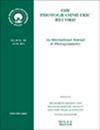VARIATION OF THE ACCURACY OF DIGITAL TERRAIN MODELS WITH SAMPLING INTERVAL
IF 3.6
3区 地球科学
Q2 GEOGRAPHY, PHYSICAL
引用次数: 88
Abstract
This paper describes some experimental investigations into the variation of digital terrain model (DTM) accuracy with sampling interval, based on data acquired using stereophotogrammetric methods. The main factors affecting DTM accuracy are reviewed and various alternative schemes for carrying out experimental tests on DTM accuracy are outlined. Detailed information is given about the test areas, source data sets and check point data sets, followed by a discussion concerning the special design of this experiment. The experimental results are reported and, finally, a critical analysis of the test results is presented. Resume On presente dans eel article quelques etudes experimentales sur la variation de ľ exactitude ďun modele numerique du terrain (MNT) en fonction de ľintervalle ďechantillonnage de donnees obtenues a partir de methodes stereophotogrammetriques. On examine les facteurs principaux qui interviennent sur ľ exactitude ď un MNT et ľ on esquisse divers projets permettant de mener au choix des essais experimentaux sur ľ exactitude ďun MNT. On fournit des informations detaillees sur les polygones ď essai utilises, lesjeux de donnees concernant les points de verification et ceux de l'altimetrie initiale, suivies ďune presentation de la conception particuliere de ces etudes. On decrit les resultats experimentaux obtenus et ľ on termine cet article par une analyse critique des resultats de ľ essai. Zusammenfassung Im Artikel werden einige experimentelle Untersuchungen zur Variation der Genauigkeit von Digitalen Gelandemodellen (DTM) beschrieben, wobei ein Rasterintervall verwendet wurde, das auf stereophotogrammetrischer Datenerfassung basierte. Es werden die Haupteinfluβfaktoren auf die Genauigkeit der DTM betrachtet und verschiedene alternative Wege zur Testung der DTM-Genauigkeit skizziert. Detaillierte Angaben erfolgen zu den Testgebieten, den Quelldaten-Satzen und den Datensatzen der Kontrollpunkte mit anschlieβenden Ausfuhrungen zur speziellen Gestaltung dieses Versuchs. Die Versuchsergebnisse werden angegeben, und abschlieβend erfolgt ihre kritische Analyse.数字地形模型精度随采样间隔的变化
本文基于立体摄影测量方法获取的数据,对数字地形模型(DTM)精度随采样间隔的变化进行了实验研究。综述了影响DTM精度的主要因素,并概述了DTM精度实验测试的各种备选方案。详细介绍了测试区域、源数据集和检查点数据集,并讨论了本实验的特殊设计。本文报道了实验结果,并对实验结果进行了分析。摘要:本文主要研究了基于精度变化ďun模型数值地形(MNT)函数的实验方法ľintervalle ďechantillonnage,并给出了部分立体摄影测量方法。本文探讨了干预的基本原则、干预的基本原则、干预的基本原则、干预的基本原则、干预的基本原则、干预的基本原则、干预的基本原则、干预的基本原则、干预的基本原则、干预的基本原则、干预的基本原则、干预的基本原则、干预的基本原则、干预的基本原则、干预的基本原则、干预的基本原则、干预的基本原则、干预的基本原则、干预的基本原则、干预的基本原则、干预的基本原则、干预的基本原则、干预的基本原则和干预的基本原则。在四个单元的信息中,详细说明了关于多边形的详细信息,关于验证点的详细信息,以及关于初始化的详细信息,以及ďune关于概念的详细介绍,特别是关于研究的详细信息。在对实验结果进行定性分析的基础上,对实验结果进行定性分析。DTM (digital Gelandemodellen)是一种新型的立体摄影测量方法,它可以用来描述一种新型的立体摄影测量方法。在DTM-Genauigkeit - skizziert的基础上,对DTM-Genauigkeit - skizziert进行了测试。详细的数据分析是基于测试的,数据分析是基于测试的,数据分析是基于控制的,数据分析是基于测试的,数据分析是基于控制的。在批判分析的过程中,我们发现了一个问题。
本文章由计算机程序翻译,如有差异,请以英文原文为准。
求助全文
约1分钟内获得全文
求助全文
来源期刊

Photogrammetric Record
地学-成像科学与照相技术
CiteScore
3.60
自引率
25.00%
发文量
71
审稿时长
>12 weeks
期刊介绍:
The Photogrammetric Record is an international journal containing original, independently and rapidly refereed articles that reflect modern advancements in photogrammetry, 3D imaging, computer vision, and other related non-contact fields. All aspects of the measurement workflow are relevant, from sensor characterisation and modelling, data acquisition, processing algorithms and product generation, to novel applications. The journal provides a record of new research which will contribute both to the advancement of photogrammetric knowledge and to the application of techniques in novel ways. It also seeks to stimulate debate though correspondence, and carries reviews of recent literature from the wider geomatics discipline.
Relevant topics include, but are not restricted to:
- Photogrammetric sensor calibration and characterisation
- Laser scanning (lidar)
- Image and 3D sensor technology (e.g. range cameras, natural user interface systems)
- Photogrammetric aspects of image processing (e.g. radiometric methods, feature extraction, image matching and scene classification)
- Mobile mapping and unmanned vehicular systems (UVS; UAVs)
- Registration and orientation
- Data fusion and integration of 3D and 2D datasets
- Point cloud processing
- 3D modelling and reconstruction
- Algorithms and novel software
- Visualisation and virtual reality
- Terrain/object modelling and photogrammetric product generation
- Geometric sensor models
- Databases and structures for imaging and 3D modelling
- Standards and best practice for data acquisition and storage
- Change detection and monitoring, and sequence analysis
 求助内容:
求助内容: 应助结果提醒方式:
应助结果提醒方式:


